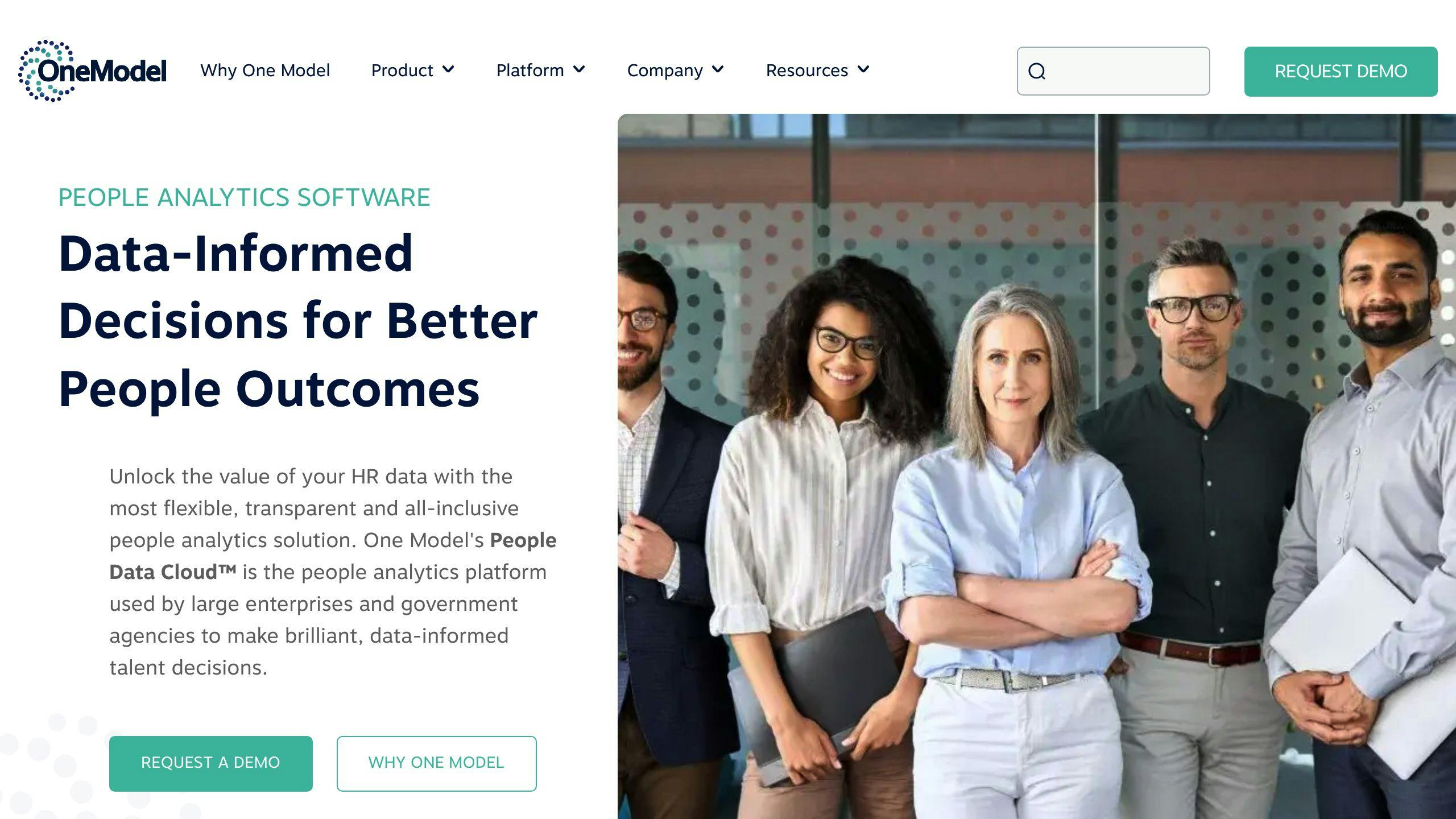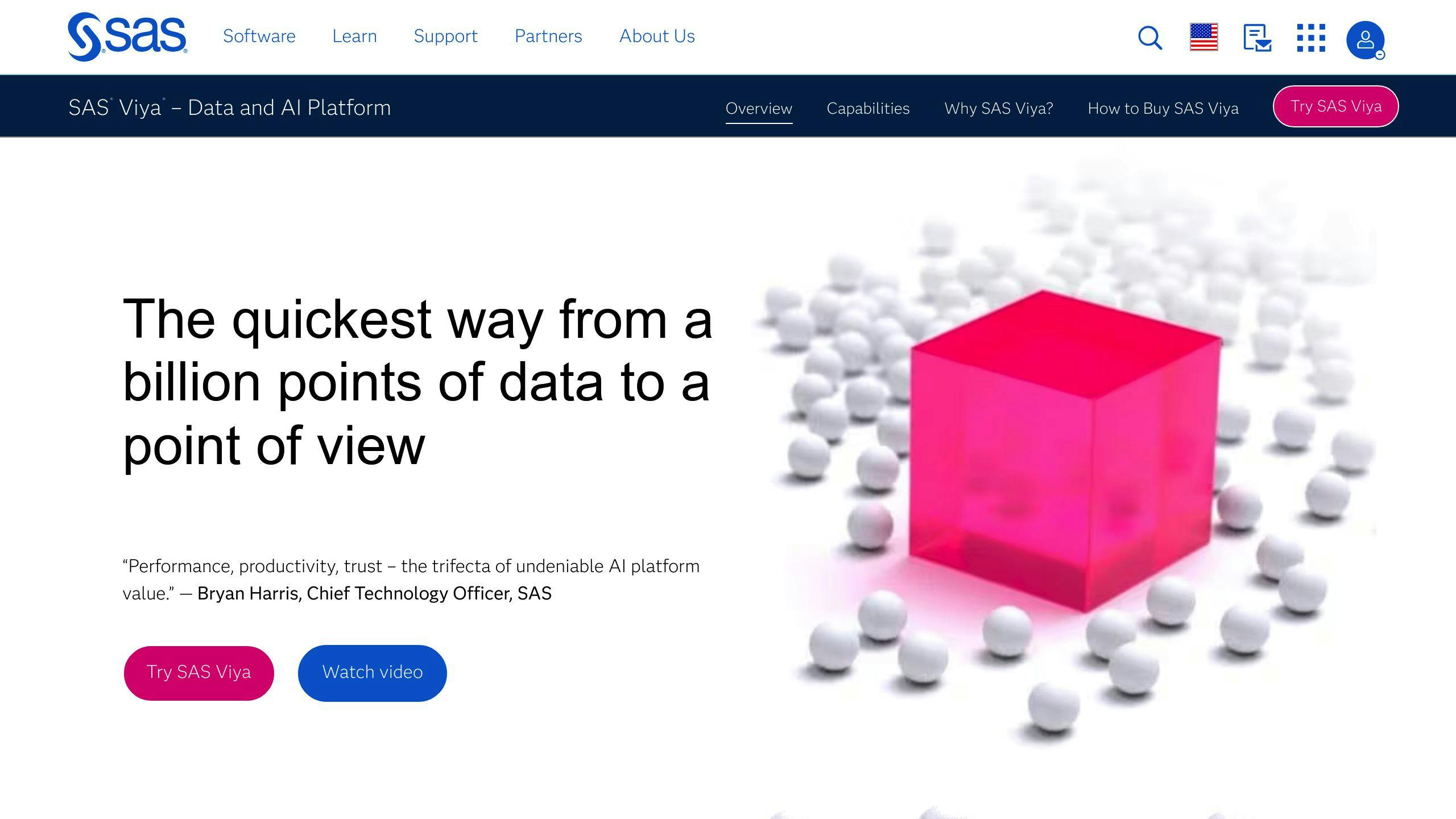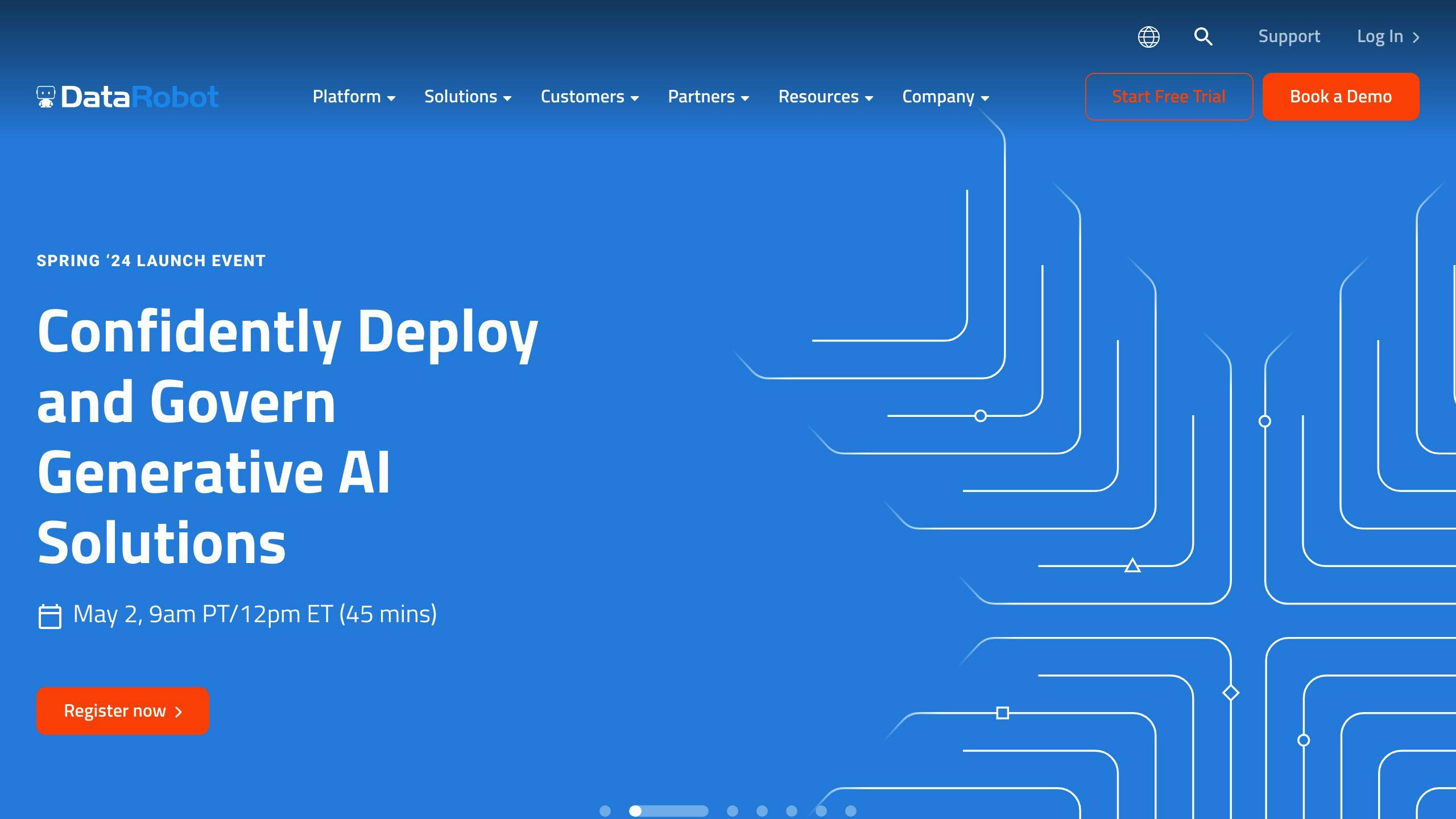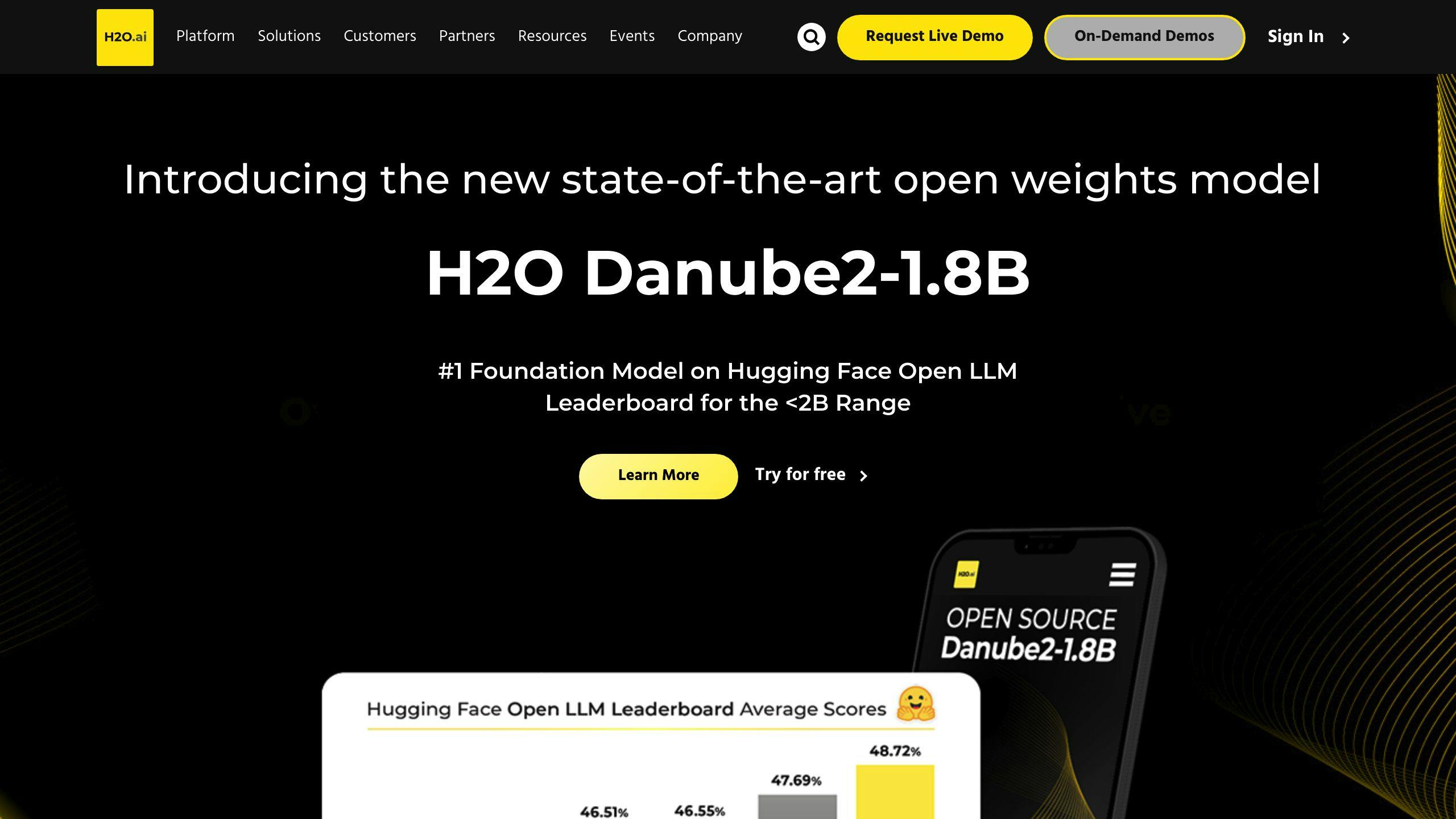Predictive analytics helps HR professionals make data-driven decisions to drive business success by identifying top talent, predicting employee turnover, optimizing recruitment, improving engagement, and developing targeted interventions.
Here are the top 10 predictive analytics tools for HR in 2024:
- SAP Analytics Cloud: Integrates with HR systems, offers automated insights, scenario modeling, and AI assistant Joule.
- One Model: Connects to HRIS, provides automated optimal model selection, bias detection, and AI platform One AI.
- Prophet: Open-source Python procedure for automatic time series forecasting.
- Scios: Simulates user behavior, offers forecasting, sales trend analysis, and visual analytics.
- SAS Viya: Automates forecasting and modeling, integrates with HR systems, and provides AI-powered insights.
- Tableau: Visualizes HR data in real-time dashboards, offers customizable templates, and AI-powered reporting.
- IBM Watson Studio: Builds and deploys predictive models, supports open-source frameworks, and offers decision optimization.
- DataRobot: Automated feature discovery, what-if analysis, and extensive integration options.
- H2O.ai: Streamlines machine learning with AutoML, scalable, and supports diverse data sources.
- Alteryx: Assisted Modeling Tool, Predictive Tools Palette, Python/R Tool, and automated workflows.
Quick Comparison
| Tool | Integration | Model Accuracy | Scalability | User Accessibility | Pricing |
|---|---|---|---|---|---|
| SAP Analytics Cloud | SAP HANA, other SAP systems | High | Scalable | User-friendly | Custom |
| One Model | Workday, BambooHR | High | Scalable | Intuitive | Custom |
| Prophet | Multiple data sources | High | Limited | User-friendly | Free (open-source) |
| Scios | API-based integration | High | Scalable | Intuitive | Custom |
| SAS Viya | SAS HR solutions | High | Scalable | User-friendly | Custom |
| Tableau | Various data sources | High | Scalable | User-friendly | Subscription |
| IBM Watson Studio | IBM HR solutions | High | Scalable | Intuitive | Custom |
| DataRobot | API-based integration | High | Scalable | User-friendly | Subscription |
| H2O.ai | APIs and connectors | High | Scalable | Intuitive | Free (open-source) |
| Alteryx | Various data sources | High | Scalable | User-friendly | Subscription |
1. SAP Analytics Cloud

Integration Capabilities
SAP Analytics Cloud integrates with existing HR systems, providing a unified view of workforce data. It pulls data from various HR software solutions and organizes it into neat dashboards, enabling HR professionals to make informed decisions.
Predictive Modeling Features
SAP Analytics Cloud offers advanced predictive modeling features, including:
- Forecasting
- Automated insights
- Scenario modeling
Its data analysis module uses AI to create forecasts, simulating various scenarios to support informed decision-making. The tool's predictive capabilities enable HR professionals to:
- Identify top-performing employees
- Predict employee turnover
- Optimize recruitment strategies
User Accessibility
SAP Analytics Cloud features a user-friendly interface, making it easy for HR professionals to navigate and utilize its predictive analytics capabilities. The platform offers a self-service portal, allowing users to access insights and analytics without requiring extensive technical expertise.
Pricing Structure
SAP Analytics Cloud offers a flexible pricing structure, with different plans tailored to meet the needs of various organizations.
| Plan | Price |
|---|---|
| Business Intelligence | $31.5/month per user |
| Planning | Available upon request |
AI and ML Enhancements
SAP Analytics Cloud leverages AI and ML to:
- Automate insights
- Accelerate analytics projects
- Enable collaborative planning
The platform's generative AI assistant, Joule, helps users to:
- Create reporting dashboards
- Automate forecasting
- Generate business plans based on findings
With its robust predictive analytics capabilities, user-friendly interface, and flexible pricing structure, SAP Analytics Cloud is an excellent choice for HR professionals seeking to drive business success through data-driven decision-making.
2. One Model

Integration Capabilities
One Model integrates with existing HR systems, providing a unified view of workforce data. It connects with various HR software solutions, organizing data into intuitive dashboards that enable HR professionals to make informed decisions.
Predictive Modeling Features
One Model offers advanced predictive modeling features, including:
- Automated optimal model selection
- Integration with One AI, its proprietary end-to-end AI platform
This enables HR teams to create predictive models without requiring extensive data science expertise. The platform's predictive capabilities allow HR professionals to:
- Identify top-performing employees
- Predict employee turnover
- Optimize recruitment strategies
User Accessibility
One Model features a user-friendly interface, making it easy for HR professionals to navigate and utilize its predictive analytics capabilities. The platform offers self-serve analytics, enabling users to access insights and analytics without requiring extensive technical expertise.
AI and ML Enhancements
One Model leverages AI and ML to:
| Enhancement | Description |
|---|---|
| Automatic optimal model selection | Applies the best predictive model for the data |
| Bias detection | Ensures equitable decision-making |
| One AI platform | Enables HR teams to create and run their own predictive models |
With its robust predictive analytics capabilities, user-friendly interface, and AI-driven insights, One Model is an excellent choice for HR professionals seeking to drive business success through data-driven decision-making.
3. Prophet
Predictive Modeling Features
Prophet is an open-source predictive analytics software that automates forecasting time series data. It's a procedure for forecasting time series data based on an additive model, handling strong seasonal effects, missing data, and shifts in the trend. Prophet is robust to outliers, missing data, and dramatic changes in your time series.
User Accessibility
Prophet is easy to use and deploy, making it a simple solution for analysts to help their organizations set goals and allocate resources more effectively. As an open-source option, Prophet is free and readily available.
Scalability
While Prophet is a great option for simple forecasting needs, it may struggle with large data sets or complex forecasts. Additionally, it lacks advanced forecasting capabilities and multivariate forecasting capabilities.
Integration Capabilities
Prophet readily integrates with popular data analysis ecosystems, making it easy to incorporate into existing HR systems.
Note: Prophet is not a traditional predictive analytics platform, but an open-source Python procedure for automatic forecasting.
4. Scios
Predictive Modeling Features
Scios is a predictive analytics software that simulates user behavior and decisions in digital environments. It combines data from various sources with macroeconomic data to provide AI-powered insights. Scios offers features like forecasting, sales trend analysis, and visual analytics, allowing users to interact with data visualization elements to drill down into data.
User Accessibility
Scios has a user-friendly interface, making it easy to navigate. It provides a self-service analytics feature, enabling users to generate reports on their own without IT involvement. Additionally, Scios offers a storytelling feature, allowing users to present data insights in a story format to their audience.
Integration Capabilities
Scios integrates with existing HR systems, resulting in a quick 1-week onboarding cycle. This allows users to easily connect and analyze data from various sources, including targets, to deliver unbiased recommendations.
Scalability
Scios is designed to handle complex forecasts and large data sets, making it a scalable solution for HR teams. Its digital environment simulation capabilities allow users to test scenarios and predict outcomes.
AI and ML Enhancements
Scios uses AI-powered insights to provide users with unbiased recommendations. Its decision intelligence solution is based on behavioral economics, allowing users to simulate user behavior and decisions in a digital environment.
| Feature | Description |
|---|---|
| Forecasting | Predicts future trends and outcomes |
| Sales Trend Analysis | Analyzes sales data to identify patterns |
| Visual Analytics | Allows users to interact with data visualization elements |
| Storytelling | Presents data insights in a story format |
| Digital Environment Simulation | Tests scenarios and predicts outcomes |
5. SAS Viya

Predictive Modeling Features
SAS Viya is a powerful predictive analytics software that automates forecasting and modeling. It allows users to generate automated forecasts and visualizations based on their data. The platform offers flexibility for automations, enabling users to tailor modeling techniques to individual data segments.
Integration Capabilities
SAS Viya integrates with existing HR systems, making it a scalable solution for HR teams. It connects and analyzes data from various sources, including targets, to deliver unbiased recommendations.
User Accessibility
While SAS Viya may have a complex nature, it is designed to be fast and responsive once onboarded effectively. However, it may take some time to onboard.
Pricing Structure
The pricing for SAS Viya is available upon request.
AI and ML Enhancements
SAS Viya uses AI-powered insights to provide users with unbiased recommendations. It allows users to feed in known events like holidays or seasonalities to help shape the forecasts to their industry.
| Feature | Description |
|---|---|
| Automated Forecasting | Generates automated forecasts and visualizations |
| Flexible Automations | Tailors modeling techniques to individual data segments |
| Data Integration | Integrates with existing HR systems and various data sources |
| AI-powered Insights | Provides unbiased recommendations using AI-powered insights |
6. Tableau

Predictive Modeling Features
Tableau is a people analytics software that helps HR professionals visualize data in shareable dashboards. It collects and tracks HR data in real-time, enabling you to create detailed dashboards from ready-built templates. The templates are customizable, so you can tailor them to your business needs. Tableau's reporting features make it easy to spot trends and make data a crucial part of your decision-making.
Integration Capabilities
Tableau integrates with existing HR systems, making it a scalable solution for HR teams. It connects and analyzes data from various sources, including targets, to deliver unbiased recommendations.
User Accessibility
Tableau is designed to be user-friendly, with a flexible and intuitive interface. While it may require some time to onboard, the platform is fast and responsive once you get started.
Pricing Structure
The pricing for Tableau is available upon request.
AI and ML Enhancements
Tableau's reporting features use AI-powered insights to provide users with unbiased recommendations. It allows users to feed in known events like holidays or seasonalities to help shape the forecasts to their industry.
| Feature | Description |
|---|---|
| Real-time Data Tracking | Collects and tracks HR data in real-time |
| Customizable Templates | Creates detailed dashboards from ready-built templates |
| AI-powered Insights | Provides unbiased recommendations using AI-powered insights |
| Integration with HR Systems | Integrates with existing HR systems and various data sources |
7. IBM Watson Studio

Predictive Modeling Features
IBM Watson Studio is a cloud-based platform that offers predictive analytics capabilities. It allows users to build and deploy predictive models using a visual interface or coding languages like Python, Scala, and R. The platform also offers prescriptive analytics with decision optimization and prepares and visualizes data.
Integration Capabilities
IBM Watson Studio can be deployed on public clouds, including IBM Cloud, AWS, Microsoft Azure, and Google Cloud. It also supports open-source frameworks and libraries, making it a scalable solution for HR teams.
User Accessibility
While some users may find the initial setup process challenging, the platform is designed to be user-friendly. Once set up, it is fast and responsive.
Pricing Structure
IBM offers a free trial of IBM Watson Studio on Cloud Pak for Data. For pricing of multiple licensing options, pay-as-you-go pricing, and IBM Cloud Pak for Data System, contact IBM.
AI and ML Enhancements
IBM Watson Studio's decision optimization model builder is a key feature that sets it apart from other predictive analytics tools. It also supports open-source frameworks and libraries, making it a great choice for HR teams looking to leverage AI and ML in their predictive analytics efforts.
| Feature | Description |
|---|---|
| Decision Optimization | Offers decision optimization model builder |
| Cloud Deployment | Deployable on public clouds |
| Open-Source Support | Supports open-source frameworks and libraries |
| Prescriptive Analytics | Offers prescriptive analytics with decision optimization |
| Data Visualization | Prepares and visualizes data |
sbb-itb-d78b90b
8. DataRobot

Predictive Modeling Features
DataRobot's AI Cloud Platform supports collaboration among users, from data science and analytics experts to business users. The platform includes data engineering, machine learning, MLOps, decision intelligence, and trusted AI services. It offers a no-code app builder, AI apps, and Decision Flows, which create rules to automate decisions. This allows business users to make AI-driven decisions without additional coding.
Integration Capabilities
DataRobot offers extensive integration options, allowing users to deploy AI services on any cloud platform, on-premise, or at the edge. This flexibility makes it a scalable solution for HR teams.
User Accessibility
The platform is designed to be user-friendly, with a no-code app builder that enables business users to make AI-driven decisions. Although users may need some time to get used to the connections, the platform is generally easy to use.
Pricing Structure
DataRobot offers a free trial, and users can contact the company for detailed pricing information.
AI and ML Enhancements
DataRobot's AI Cloud Platform provides:
| Feature | Description |
|---|---|
| Automated Feature Discovery | Automates feature discovery |
| What-if Analysis | Enables what-if analysis capability |
| Integration Options | Offers extensive integration options |
| AI Service Deployment | Deploys AI services on any cloud platform, on-premise, or at the edge |
| Compliance Reports | Generates compliance reports |
9. H2O.ai

Predictive Modeling Features
H2O.ai's platform offers advanced automation and scalability, enabling organizations to harness the power of artificial intelligence and predictive analytics. Key features include AutoML, which streamlines the machine learning process, and a rich library of advanced algorithms. This allows data scientists and analysts to tackle complex problems and extract valuable insights from their data.
Integration Capabilities
H2O.ai supports diverse data sources, including structured and unstructured data, ensuring that organizations can leverage their entire data ecosystem for predictive analytics. The platform offers flexible deployment options, allowing users to deploy models in cloud environments, on-premises, or at the edge, aligning with their specific infrastructure and security requirements.
User Accessibility
H2O.ai's platform is designed to be user-friendly, with AutoML capabilities making machine learning accessible to a broader range of users. While it may require some time to learn, the platform's efficiency and support for large datasets make it a valuable tool for HR teams.
Pricing Structure
H2O.ai offers a free trial, and users can contact the company for detailed pricing information.
AI and ML Enhancements
H2O.ai's platform provides:
| Feature | Description |
|---|---|
| AutoML | Streamlines the machine learning process |
| Scalability | Handles both small and large datasets with ease |
| Interpretability | Provides tools and techniques for explaining complex machine learning models |
| Efficiency | Reduces the time and resources required to develop and deploy models |
| Open Source | Fosters collaboration and innovation |
| Flexible Deployment | Deploys models in cloud environments, on-premises, or at the edge |
| Support for Diverse Data Sources | Leverages entire data ecosystem for predictive analytics |
10. Alteryx

Predictive Modeling Features
Alteryx offers a range of predictive modeling features, including its Assisted Modeling Tool, Predictive Tools Palette, and Python/R Tool. These tools enable users to conduct predictive analytics on their data, from guided processes to advanced modeling capabilities.
Integration Capabilities
Alteryx supports seamless integration with various data sources, allowing users to leverage their entire data ecosystem for predictive analytics. Its cloud-based platform, Alteryx Analytics Cloud, provides flexible deployment options, enabling users to deploy models in cloud environments, on-premises, or at the edge.
User Accessibility
Alteryx's platform is designed to be user-friendly, with automated workflows and flexible data connections to data warehouses/lakes. While it may require some time to learn, the platform's efficiency and support for large datasets make it a valuable tool for HR teams.
Pricing Structure
Alteryx offers a range of pricing plans, including:
| Plan | Price |
|---|---|
| Designer Cloud | $4,950 |
| Designer Desktop | $5,195 |
| Machine Learning (add-on) | Available upon request |
AI and ML Enhancements
Alteryx's platform provides several AI and ML enhancements, including:
| Feature | Description |
|---|---|
| Assisted Modeling Tool | Guides users through a step-by-step process for predictive modeling |
| Predictive Tools Palette | Offers a range of predictive tools for intermediate users |
| Python/R Tool | Enables advanced users to leverage Python and R for predictive modeling |
| Automated Workflows | Streamlines the predictive analytics process |
| Flexible Data Connections | Supports connections to various data sources and warehouses/lakes |
Comparing the Tools
When choosing a predictive analytics tool for HR, it's crucial to compare their features, capabilities, and pricing models. Here's a comprehensive comparison of the 10 predictive analytics tools for HR discussed in this article:
Integration with HR Systems
| Tool | Integration Capabilities |
|---|---|
| SAP Analytics Cloud | Integrates with SAP HANA and other SAP systems |
| One Model | Integrates with various HRIS systems, including Workday and BambooHR |
| Prophet | Supports integration with multiple data sources, including HR systems |
| Scios | Offers API-based integration with various HR systems and data sources |
| SAS Viya | Integrates with SAS HR solutions and other HR systems |
| Tableau | Connects to various data sources, including HR systems and cloud storage |
| IBM Watson Studio | Supports integration with IBM HR solutions and other HR systems |
| DataRobot | Offers API-based integration with various HR systems and data sources |
| H2O.ai | Integrates with various HR systems and data sources using APIs and connectors |
| Alteryx | Supports integration with various data sources, including HR systems and cloud storage |
Model Accuracy and Scalability
| Tool | Model Accuracy | Scalability |
|---|---|---|
| SAP Analytics Cloud | High accuracy with automated machine learning | Scalable for large datasets |
| One Model | High accuracy with proprietary AI algorithms | Scalable for large datasets |
| Prophet | High accuracy with automated machine learning | Scalable for large datasets |
| Scios | High accuracy with machine learning models | Scalable for large datasets |
| SAS Viya | High accuracy with advanced analytics | Scalable for large datasets |
| Tableau | High accuracy with data visualization | Scalable for large datasets |
| IBM Watson Studio | High accuracy with AI-powered analytics | Scalable for large datasets |
| DataRobot | High accuracy with automated machine learning | Scalable for large datasets |
| H2O.ai | High accuracy with machine learning models | Scalable for large datasets |
| Alteryx | High accuracy with automated machine learning | Scalable for large datasets |
User Accessibility and Pricing Structure
| Tool | User Accessibility | Pricing Structure |
|---|---|---|
| SAP Analytics Cloud | User-friendly interface | Custom pricing for enterprise customers |
| One Model | Intuitive interface | Custom pricing for enterprise customers |
| Prophet | User-friendly interface | Open-source, free to use |
| Scios | Intuitive interface | Custom pricing for enterprise customers |
| SAS Viya | User-friendly interface | Custom pricing for enterprise customers |
| Tableau | User-friendly interface | Subscription-based pricing |
| IBM Watson Studio | Intuitive interface | Custom pricing for enterprise customers |
| DataRobot | User-friendly interface | Subscription-based pricing |
| H2O.ai | Intuitive interface | Open-source, free to use |
| Alteryx | User-friendly interface | Subscription-based pricing |
When selecting a predictive analytics tool for HR, consider the specific needs of your organization, including the level of integration required with existing HR systems, the accuracy and scalability of the tool, and the user accessibility and pricing structure. By evaluating these factors, you can choose the best tool for your HR team to drive data-driven decision-making and improve business outcomes.
Pros and Cons Summary
When choosing a predictive analytics tool for HR, it's crucial to weigh the advantages and disadvantages of each option. Here's a summary of the pros and cons of each tool to help you make an informed decision:
Tool Comparison
| Tool | Pros | Cons |
|---|---|---|
| SAP Analytics Cloud | High accuracy, scalable, user-friendly | Custom pricing, may require training |
| One Model | High accuracy, intuitive interface, scalable | Custom pricing, limited free resources |
| Prophet | High accuracy, open-source, user-friendly | Limited scalability, may require technical expertise |
| Scios | High accuracy, intuitive interface, scalable | Custom pricing, limited free resources |
| SAS Viya | High accuracy, advanced analytics, scalable | Custom pricing, steep learning curve |
| Tableau | High accuracy, user-friendly, scalable | Subscription-based pricing, limited free resources |
| IBM Watson Studio | High accuracy, AI-powered analytics, scalable | Custom pricing, complex setup |
| DataRobot | High accuracy, automated machine learning, scalable | Subscription-based pricing, limited free resources |
| H2O.ai | High accuracy, machine learning models, scalable | Open-source, may require technical expertise |
| Alteryx | High accuracy, automated machine learning, scalable | Subscription-based pricing, limited free resources |
By considering the pros and cons of each tool, you can choose the best predictive analytics solution for your HR team's specific needs and budget.
Final Thoughts
Choosing the right predictive analytics tool for HR is crucial for driving business growth, improving employee retention, and enhancing overall HR efficiency. To make an informed decision, consider the following key factors:
Key Considerations
| Factor | Description |
|---|---|
| Accuracy | Look for tools with high accuracy rates to ensure reliable predictions and insights. |
| Scalability | Select a tool that can grow with your organization, handling increasing amounts of data and complexity. |
| User-friendliness | Opt for a tool with an intuitive interface, making it easy for HR professionals to use and interpret results. |
| Customization | Choose a tool that allows for customization to meet your organization's specific needs and goals. |
| Cost | Evaluate the total cost of ownership, including any subscription fees, training costs, and potential ROI. |
By considering these factors, you can select a predictive analytics tool that aligns with your organization's needs and objectives.
Tips for Success
To get the most out of your predictive analytics tool, remember:
- Use data to inform decisions: Rely on data-driven insights rather than intuition or guesswork.
- Start small: Begin with a specific use case or project and scale up as needed.
- Involve stakeholders: Engage HR professionals and other stakeholders in the selection and implementation process.
- Monitor and evaluate: Continuously assess the tool's performance and adjust as needed.
By following these tips and choosing the right predictive analytics tool, you can unlock the full potential of your HR team and drive business success.
FAQs
What is a predictive model for employee retention?
A predictive model for employee retention uses factors like job role longevity, monthly engagement scores, and recent promotion history to calculate a turnover risk score for each employee. This helps identify which employees are at risk of leaving based on key indicators.
| Predictive Model Factors | Description |
|---|---|
| Job Role Longevity | How long an employee has been in their current role |
| Monthly Engagement Scores | Employee satisfaction and engagement levels |
| Recent Promotion History | If an employee has received a promotion recently |
By using these factors, the predictive model can identify employees who are more likely to leave the organization, allowing HR to take proactive measures to retain them.


